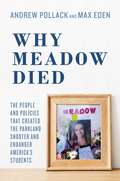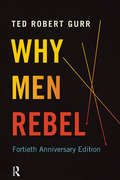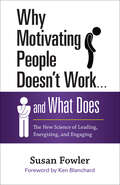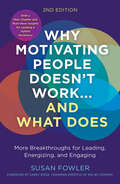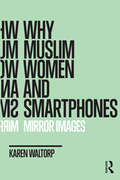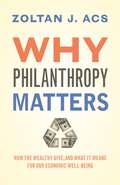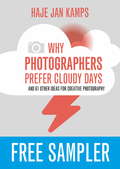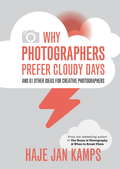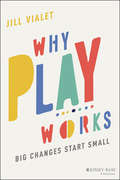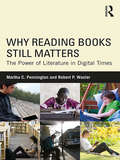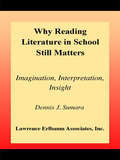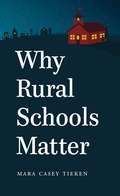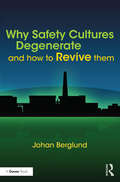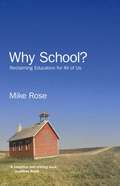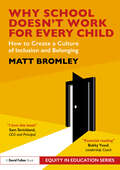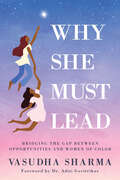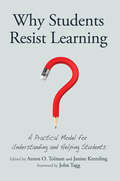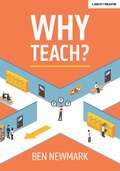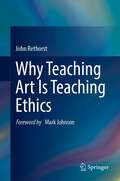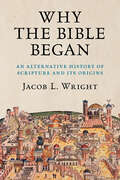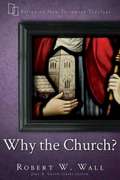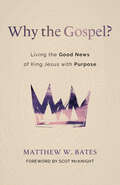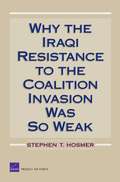- Table View
- List View
Why Meadow Died: The People and Policies That Created The Parkland Shooter and Endanger America's Students
by Max Eden Andrew PollackThe Parkland school shooting was the most avoidable mass murder in American history. And the policies that made it inevitable are being forced into public schools across America.“After my sister Meadow was murdered at Marjory Stoneman Douglas High School, the media obsessed for months about the type of rifle the killer used. It was all clickbait and politics, not answers or justice. That wasn’t good enough for us. My dad is a real tough guy, but Meadow had him wrapped around her little finger. He would do anything she wanted, and she would want him to find every answer so that this never happens again. My dad teamed up with one of America’s leading education experts to launch his own investigation. We found the answers to the questions the media refused to ask. Questions about school safety that go far beyond the national gun debate. And the answers to those questions matter for parents, teachers, and schoolchildren nationwide. If one single adult in the Broward County school district had made one responsible decision about the Parkland shooter, then my sister would still be alive. But every bad decision they made makes total sense once you understand the district’s politically correct policies, which started here in Broward and have spread to thousands of schools across America.” —Hunter Pollack, “Foreword”
Why Men Rebel
by Ted Robert GurrWhy Men Rebel was first published in 1970 after a decade of political violence across the world. Forty years later, serious conflicts continue in Africa, Asia and the Middle East. Ted Robert Gurr reintroduces us to his landmark work, putting it in context with the research it influenced as well as world events. Why Men Rebel remains highly relevant to today's violent and unstable world with its holistic, people-based understanding of the causes of political protest and rebellion. With its close eye on the politics of group identity, this book provides new insight into contemporary security challenges.
Why Motivating People Doesn't Work . . . and What Does: The New Science of Leading, Energizing, and Engaging
by Susan FowlerTop leadership researcher, consultant, and coach Susan Fowler says stop trying to motivate people! It's frustrating for everyone involved and it just doesn't work. You can't motivate people--they are already motivated but generally in superficial and short-term ways. In this book, Fowler builds upon the latest scientific research on the nature of human motivation to lay out a tested model and course of action that will help leaders guide their people toward the kind of motivation that not only increases productivity and engagement but that gives them a profound sense of purpose and fulfillment. Fowler argues that leaders still depend on traditional carrot-and-stick techniques because they haven't understood their alternatives and don't know what skills are necessary to apply the new science of motivation. Her Optimal Motivation process shows leaders how to move people away from dependence on external rewards and help them discover how their jobs can meet the deeper psychological needs--for autonomy, relatedness, and competence--that science tells us result in meaningful and sustainable motivation. Optimal Motivation has been proven in organizations all over the world--Fowler's clients include Microsoft, CVS, NASA, the Catholic Leadership Institute, H&R Block, Mattel, and dozens more. Throughout the book, she illustrates how each step of the process works using real-life examples. Susan Fowler 's book is the groundbreaking answer for leaders who want to get motivation right!
Why Motivating People Doesn't Work…and What Does, Second Edition: More Breakthroughs for Leading, Energizing, and Engaging
by Susan FowlerWhat if the answer to motivating people is to stop trying to motivate them?The second edition of this bestseller reveals how motivation science is essential for solving the most vexing leadership issues-from hybrid work and retention to employee engagement.Leaders face a motivation dilemma. Traditional command-and-control management styles and carrot-and-stick motivation techniques have been proven ineffective.Motivation researcher and leadership consultant Susan Fowler expands on her groundbreaking Spectrum of Motivation model in this updated post-pandemic edition. New chapters tackle motivation science's role in managing remote and hybrid work; expose overused tactics, such as gamification and tokens; and tell the fascinating backstory behind the great resignation and quiet quitting. Fowler's approach to leadership is fresh, pragmatic, and inspiring. But it's also empirically sound. Her framework builds on Self-Determination Theory, equipping leaders with skills to encourage choice, deepen connection, and build competence. Leaders who mastered this method have experienced breakthroughs with higher retention, lower turnover, greater acceptance of DEIJ initiatives, and a more vital, creative, and resilient workforce. Through her experiences working with organizations and leaders around the world, Fowler reminds us that motivation is at the heart of everything people do and everything they don't do but wish they did. When managers integrate motivation science into their everyday leadership practice, an evolutionary truth emerges: people can be highly productive and flourish simultaneously.
Why Muslim Women and Smartphones: Mirror Images (Criminal Practice Ser.)
by Karen WaltorpUsing an assemblage approach to study how Muslim women in Norrebro, Denmark use their phones, Karen Waltorp examines how social media complicates the divide between public and private in relation to a group of people who find this distinction of utmost significance. Building on years of ethnographic fieldwork, Waltorp's ethnography reflects the trust and creativity of her relationships with these women which in turn open up nuanced discussions about both the subject at hand and best practice in conducting anthropological research. Combining rich ethnography with theoretical contextualization, Waltorp's book alternates between ethnography and analysis to illuminate a thoroughly modern community, and reveals the capacity of image-making technology to function as an infrastructure for seeing, thinking and engaging in fieldwork as an anthropologists. Waltorp identifies a series of important issues around anthropological approaches to new media, contributing to new debates around the anthropology of automation, data and self-tracking.
Why Philanthropy Matters: How the Wealthy Give, and What It Means for Our Economic Well-Being
by Zoltan AcsThe hidden role of philanthropy in enriching America's prosperity—and the world'sPhilanthropy has long been a distinctive feature of American culture, but its crucial role in the economic well-being of the nation—and the world—has remained largely unexplored. Why Philanthropy Matters takes an in-depth look at philanthropy as an underappreciated force in capitalism, measures its critical influence on the free-market system, and demonstrates how American philanthropy could serve as a model for the productive reinvestment of wealth in other countries. Factoring in philanthropic cycles that help balance the economy, Zoltan Acs offers a richer picture of capitalism, and a more accurate backdrop for considering policies that would promote the capitalist system for the good of all.Examining the dynamics of American-style capitalism since the eighteenth century, Acs argues that philanthropy achieves three critical outcomes. It deals with the question of what to do with wealth—keep it, tax it, or give it away. It complements government in creating public goods. And, by focusing on education, science, and medicine, philanthropy has a positive effect on economic growth and productivity. Acs describes how individuals such as Benjamin Franklin, Andrew Carnegie, Bill Gates, and Oprah Winfrey have used their wealth to establish institutions and promote knowledge, and Acs shows how philanthropy has given an edge to capitalism by promoting vital forces—like university research—necessary for technological innovation, economic equality, and economic security. Philanthropy also serves as a guide for countries with less flexible capitalist institutions, and Acs makes the case for a larger, global philanthropic culture.Providing a new perspective on the development of capitalism, Why Philanthropy Matters highlights philanthropy's critical links to the economic progress, health, and future of the United States—and beyond.
Why Photographers Prefer Cloudy Days: Surprising And Inspiring Tips For Photographers
by Haje Jan Kamps**FREE SAMPLER** There's no one secret to taking beautiful photos, but good photographers build up a series of useful bits of know-how. They know that clouds, far from ruining a photo, give a great soft natural light for portraits. They know that unusual angles draw the eye, and that their feet are just as effective as a zoom lens.This book packs 62 of the most important creative ideas into one easy-to-read location, beautifully presented with example photos. None of these ideas need an expensive camera, fancy lens or a over-priced flash. The purpose of this book is to help you tell stories with your camera, whatever the camera.Whether you're photographing that perfect sunset or your morning coffee, Why Photographers Prefer Cloudy Days will show you how to capture it to best effect, whether you want it to look great on your Instagram, or amazing on your wall.
Why Photographers Prefer Cloudy Days: and 61 Other Ideas for Creative Photography
by Haje Jan KampsThere's no one secret to taking beautiful photos. But good photographers do have a few tricks up theirsleeves... They know that clouds, far from ruining a photo, give a great soft natural light for portraits. They know that unusual angles draw the eye, and that their feet are just as effective as a zoom lens.This book packs 62 of the most important creative ideas into one place. Beautifully presented, easy-to-read and packed with example photos. None of these ideas need an expensive camera, fancy lens or a over-priced flash. The purpose of this book is to help you tell stories with your camera (or phone).Whatever you want to shoot, Why Photographers Prefer Cloudy Days is packed full of ideas to inspire you, and tips that will help you take better, more original photos.
Why Photographers Prefer Cloudy Days: Surprising And Inspiring Tips For Photographers
by Haje Jan KampsThere's no one secret to taking beautiful photos. But good photographers do have a few tricks up theirsleeves... They know that clouds, far from ruining a photo, give a great soft natural light for portraits. They know that unusual angles draw the eye, and that their feet are just as effective as a zoom lens.This book packs 62 of the most important creative ideas into one place. Beautifully presented, easy-to-read and packed with example photos. None of these ideas need an expensive camera, fancy lens or a over-priced flash. The purpose of this book is to help you tell stories with your camera (or phone).Whatever you want to shoot, Why Photographers Prefer Cloudy Days is packed full of ideas to inspire you, and tips that will help you take better, more original photos.
Why Play Works: Big Changes Start Small
by Jill VialetHarness the power of play in building learning environments that help students thrive In Why Play Works, expert educator and author Jill Vialet shares her insights from a career of promoting play. Designed to support schools, education professionals and parents in promoting play as an essential tool for increasing social connection amongst their students, you'll find out why playing is a behavior that's helped children learn to navigate the demands of social interaction for eons, and how we can keep it central to their school experience even as we return from the COVID-19 pandemic. In this book, you'll discover: Why it's important to intentionally integrate play into day-to-day school operations because of its ability to help students learn to manage risks, develop greater self awareness, and build confidence Ways of incorporating play into space – both in-person and remote – that contribute to responsive, flexible and sustainable teaching and learning environments Real examples of schools leveraging play to promote youth leadership and student agency How to incorporate play in co-creating new approaches to education, building off the insight that big changes start small Perfect for educators, school administrators, parents of school-age children, and anyone who is simply play-curious, Why Play Works is intended to prompt your thinking about all the ways in which play can be a tool for helping to bring out the best in our kids.. The book stands out as a thoughtful, playful and effective guide for supporting the learning and well-being of students everywhere.
Why Reading Books Still Matters: The Power of Literature in Digital Times
by Martha C. Pennington Robert P. WaxlerBringing together strands of public discourse about valuing personal achievement at the expense of social values and the impacts of global capitalism, mass media, and digital culture on the lives of children, this book challenges the potential of science and business to solve the world’s problems without a complementary emphasis on social values. The selection of literary works discussed illustrates the power of literature and human arts to instill such values and foster change. The book offers a valuable foundation for the field of literacy education by providing knowledge about the importance of language and literature that educators can use in their own teaching and advocacy work.
Why Reading Literature in School Still Matters: Imagination, Interpretation, Insight
by Dennis J. SumaraWhy Reading Literature in School Still Matters: Imagination, Interpretation, Insight explains how a reader's involvement with literary texts can create conditions for developing deep insight into human experience, and how teachers can develop these interpretive possibilities in school contexts. Developed from the author's many years of research, this book offers both a theoretical framework that draws from an interdisciplinary array of sources and many compelling and insightful examples of literary engagement of child, adolescent, and adult readers, as well as practical advice for teachers and other readers about how to create interesting and expansive sites for interpretation that are personally rewarding and productive. Why Reading Literature in School Still Matters: Imagination, Interpretation, Insight : *provides an overview of theories of human learning that influence beliefs about language, culture, and identity; *shows how these theories of learning influence beliefs about and practices of reading and interpretation; *introduces new ways to conceptualize reading that emphasize the relationship between individual and collective identities and language/literacy practices; *explains why access to information does not guarantee that understanding and/or insight will occur--by emphasizing the importance of "re-reading" and "close reading" this text shows that development of deep insight depends on interpretation skills that must be taught; and *presents a reconceptualized view of reading pedagogy. This is an essential text for education courses at both the undergraduate and graduate levels and a must read for teachers and for anyone interested in more deeply understanding how literary works of art can create conditions for learning about oneself, one's situation, and one's possibilities.
Why Rural Schools Matter
by Mara Casey TiekenFrom headlines to documentaries, urban schools are at the center of current debates about education. From these accounts, one would never know that 51 million Americans live in rural communities and depend on their public schools to meet not only educational but also social and economic needs. For many communities, these schools are the ties that bind. Why Rural Schools Matter shares the untold story of rural education. Drawing upon extensive research in two southern towns, Mara Tieken exposes the complicated ways in which schools shape the racial dynamics of their towns and sustain the communities that surround them. The growing power of the state, however, brings the threat of rural school closure, which jeopardizes the education of children and the future of communities. With a nuanced understanding of the complicated relationship between communities and schools, Tieken warns us that current education policies--which narrow schools' purpose to academic achievement alone--endanger rural America and undermine the potential of a school, whether rural or urban, to sustain a community. Vividly demonstrating the effects of constricted definitions of public education in an era of economic turmoil and widening inequality, Tieken calls for a more contextual approach to education policymaking, involving both state and community.
Why Safety Cultures Degenerate: And How To Revive Them
by Johan BerglundFrom Chernobyl to Fukushima, have we come full circle, where formalisation has replaced ambiguity and a decadent style of management, to the point where it is becoming counter-productive? Safety culture is a contested concept and a complex phenomenon, which has been much debated in recent years. In some high-risk activities, like the operating of nuclear power plants, transparency, traceability and standardisation have become synonymous with issues of quality. Meanwhile, the experience-based knowledge that forms the basis of manuals and instructions is liable to decline. In the long-term, arguably, it is the cultural changes and its adverse impacts on co-operation, skill and ability of judgement that will pose the greater risks to the safety of nuclear plants and other high-risk facilities. Johan Berglund examines the background leading up to the Fukushima Daiichi accident in 2011 and highlights the function of practical proficiency in the quality and safety of high-risk activities. The accumulation of skill represents a more indirect and long-term approach to quality, oriented not towards short-term gains but (towards) delayed gratification. Risk management and quality professionals and academics will be interested in the links between skill, quality and safety-critical work as well as those interested in a unique insight into Japanese culture and working life as well as fresh perspectives on safety culture.
Why School?
by Mike RoseWhy School? is a little book driven by big questions. What does it mean to be educated? What is intelligence? How should we think about intelligence, education, and opportunity in an open society? Drawing on forty years of teaching and research and "a profound understanding of the opportunities, both intellectual and economic, that come from education" (Booklist), award-winning author Mike Rose reflects on these and other questions related to public schooling in America. He answers them in beautifully written chapters that are both rich in detail and informed by an extensive knowledge of history, the psychology of learning, and the politics of education.This paperback edition includes three new chapters showing how cognitive science actually narrows our understanding of learning, how to increase college graduation rates, and how to value the teaching of basic skills. An updated introduction by Rose, who has been hailed as "a superb writer and an even better storyteller" (TLN Teachers Network), reflects on recent developments in school reform. Lauded as "a beautifully written work of literary nonfiction" (The Christian Science Monitor) and called "stunning" by the New Educator Journal, Why School? offers an eloquent call for a bountiful democratic vision of the purpose of schooling.
Why School Doesn’t Work for Every Child: How to Create a Culture of Inclusion and Belonging (Equity in Education Series)
by Matt BromleyEvery child, no matter their starting point or background and no matter their additional and different needs, should have an equitable chance of success at school.This first book in the Equity in Education series looks at how schools can foster a better sense of belonging and ensure they are truly inclusive of all learners, thus mitigating the effects of an increasingly unequal, fractured society. To ensure a child’s birth does not also become their life’s destiny, Matt Bromley shows how an inclusive school culture can be created through a process that is as simple as ABC: Attendance: raising the attendance and punctuality of disadvantaged learners Behaviours: helping students develop appropriate behaviours for learning so that they can conduct themselves positively and develop the skills needed to access an increasingly challenging curriculum Community: building a community around learners by putting family first and engaging with parents as partners in the process of educating their child Offering actionable guidance and strategies that can be used to support school development plans, the book sets out the practical ways schools can create a collaborative culture in which all staff understand the importance of inclusion as well as the part they play in helping to achieve it. As such, it is essential reading for all teachers and school leaders who want to ensure that every child has an equitable chance of success at school and in later life.
Why She Must Lead: Bridging the Gap Between Opportunities and Women of Color
by Vasudha SharmaA passionate advocate for women of color shares her personal story as well as interviews with female changemakers across the globe.Vasudha Sharma immigrated to the United States to find better opportunities. She soon discovered what the glass ceiling looks like in one of the world’s most advanced nations. Today, that ceiling shows some encouraging cracks—from more executive women to Kamala Harris’s historic ascent to the vice presidency. But how long will it take for a major impact to finally shatter it? In Why She Must Lead, Vasudha draws on inspiration and interviews with women around the world to envision how issues like the pay gap, broken rungs, and lack of mentorship can be filtered out systematically, and how workplaces can uplift the most underrepresented group of women. Vasudha kindles the call for women of color to challenge the status quo and lead with purpose. Why She Must Lead will help women: • Analyze reports related to the leadership gap for minority women • Understand the causes for a leaky talent pipeline • Create personalized approaches to eliminating barriers and bias • Deepen their insight about how to minimize the leadership gap • Rise as a leader to champion equity goals for themselves or their organization
Why Students Resist Learning: A Practical Model for Understanding and Helping Students
by John Tagg Anton O. Tolman Janine KremlingHowever personally committed faculty may be to helping students learn, their students are not always as eager to participate in this endeavor, and may react with both active and passive resistant behaviors, including poor faculty evaluations. The purpose of this book is to help faculty develop a coherent and integrated understanding of the various causes of student resistance to learning, providing them with a rationale for responding constructively, and enabling them to create conditions conducive to implementing effective learning strategies. In this book readers will discover an innovative integrated model that accounts for student behaviors and creates a foundation for intentional and informed discussion, evaluation, and the development of effective counter strategies. The model takes into account institutional context, environmental forces, students’ prior negative classroom experiences, their cognitive development, readiness to change, and metacognition. The various chapters take the reader through the model’s elements, exploring their practical implications for teaching, whether relating to course design, assessments, assignments, or interactions with students.The book includes a chapter written entirely by students, offering their insights into the causes of resistance, and their reflections on how participating on this project has affected them. While of great value for faculty, this book is also useful to faculty developers advising future and current faculty, as well as to administrators, offering insight into how institutional values impact teaching practice and student attitudes.
Why Teach?
by Ben NewmarkAt the start of his career, Ben Newmark assumed that all the things he was told to do, from how to teach to how to record the progress of my pupils, were well planned and necessary. Sometimes things didn't feel right and seemed bizarre but, for the first couple of years of his career, he assumed this was because he was not skilled, knowledgeable or experienced enough to understand the rationale. But he couldn't keep this up forever. So he began to ask questions. And then he asked more. And the more he learned the more confused he became. To his horror it became clear that there wasn't a masterplan. Instead, education was a world full of contradictory thinking, bad planning and unintended consequences. Each chapter of this book tries to answer one of the questions he struggled with, trying to explain the reasons for the oddness and then give some advice on how schools and individual teachers might manage it. And it is possible to do better than manage it. For all its frustrating weirdness there isn't another job in the world he'd rather do. When finally he has to retire, he will be begging his closest school to teach two or three classes a week. Including chapters such as: Why are there so many spreadsheets in schools?; Why doesn't my school behaviour system work?; Why is teaching making me so unhealthy?; and Why won't my pupils work hard?
Why Teach?
by Ben NewmarkAt the start of his career, Ben Newmark assumed that all the things he was told to do, from how to teach to how to record the progress of my pupils, were well planned and necessary. Sometimes things didn't feel right and seemed bizarre but, for the first couple of years of his career, he assumed this was because he was not skilled, knowledgeable or experienced enough to understand the rationale. But he couldn't keep this up forever. So he began to ask questions. And then he asked more. And the more he learned the more confused he became. To his horror it became clear that there wasn't a masterplan. Instead, education was a world full of contradictory thinking, bad planning and unintended consequences. Each chapter of this book tries to answer one of the questions he struggled with, trying to explain the reasons for the oddness and then give some advice on how schools and individual teachers might manage it. And it is possible to do better than manage it. For all its frustrating weirdness there isn't another job in the world he'd rather do. When finally he has to retire, he will be begging his closest school to teach two or three classes a week. Including chapters such as: Why are there so many spreadsheets in schools?; Why doesn't my school behaviour system work?; Why is teaching making me so unhealthy?; and Why won't my pupils work hard?
Why Teaching Art Is Teaching Ethics
by John RethorstThis exhaustively-researched, carefully-focused book asks whether imagination, emotion and art can enlighten our sense of right and wrong, looking at this question through the lens of moral philosophy with contributions from cognitive science, psychology and neurology.If moral thinking is simply logical reasoning or following God-given law, why did the poet Shelley say that “the great instrument of moral good is the imagination”? Why does ethical reasoning tend towards absolutes: something is either right or wrong, period, while a thoughtful minority values the “priority of the particular” – that unique aspects of a situation may come closer to the heart of the matter than any general rules could? Are emotions, as many philosophers in history have theorized, only a distraction from the clear perception of duty, or do feelings add something important, even critical, to how we judge good and bad, right and wrong? Can great works of art and literature embody imagination, the particular, and emotions to illuminate human life in ways crucial to ethical thinking?This book introduces an original idea in philosophy, “moral density,” which for the first time elucidates the profound relation between art and ethics. Written for the literate layperson, an academic or technical background is not necessary, so this book will be of interest not only to philosophers and educators, but to all who are concerned with what is good, and how to see it and teach it.
Why the Bible Began: An Alternative History of Scripture and its Origins
by Jacob L. WrightWhy did no other ancient society produce a text remotely like the Bible? That a tiny, out of the way community, could have produced a text so determinative for peoples across the globe seems improbable.For Jacob Wright, the Bible is not only a testimony of survival, but also an unparalleled achievement in human history. Forged during Babylonian exile after the shattering destruction of Jerusalem, it makes not victory but total humiliation the foundation of a new idea of belonging. Lamenting the destruction of their homeland, scribes who composed the Bible turned to the golden ages of the past, reflecting deeply on abject failure. More than just religious scripture, the Bible is a resonant blueprint for the inspiring creation of a nation. As a response to catastrophe, it offers a powerful, message of hope and restoration that is unique in the Ancient Near Eastern and Greco-Roman worlds. Wright's Bible is thus a social, political, and even economic roadmap – one that enabled a small and obscure community located on the periphery of leading civilizations and empires, not just to come back from the brink, but ultimately to shape the world's destiny. The Bible speaks ultimately of being a united, yet diverse people, and its pages present a manual of pragmatic survival strategies in response to societal collapse.
Why the Church? (Reframing New Testament Theology)
by Joel B. Green Robert W. WallGiven the way many in the West have read the New Testament in the last century, the church might be regarded as an afterthought at best. But at the worst, it can be viewed as an unnecessary, perhaps even problematic, institutionalization of genuine faith especially in our post-denominational context. These perspectives fly in the face of the robust ecclesiological concerns and commitments of the New Testament documents when read as witnesses from, to, and for congregations of God's people. For Wall, the problem is spiritual because fewer go to find God in church. Why the church? Because this peculiar fellowship of saints, whose loving communion is with the risen One, has been appointed by the triune God as God's herald. With its sacred vocation, every demonstration of the church's oneness, holiness, catholicity, and apostolicity--each eschatological mark enabled and brought to maturity by God's grace--is the concrete means to address our theological crisis. This book will contribute to New Testament studies but also serve related discussions in theology and church history. Reframing New Testament Theology is a series that fulfills the need for brief, substantive, yet highly accessible introductions to central questions and themes raised by New Testament study.
Why the Gospel?: Living the Good News of King Jesus with Purpose
by Matthew W. BatesWe know what the gospel is—but do we know why it is? As Christians, we often ask what the gospel is, when we should be asking why it is. Matthew W. Bates has previously demonstrated that the &“good news&” of the gospel is that Jesus is King. But in his latest book, he explores God&’s intentions: why has God issued this royal proclamation? And what role can it play in our everyday lives? As Bates observes, we find the answer in a simple but challenging realization: &“I am a horrible king of my own life.&” With examples from Scripture, literature, and personal experience, Bates explains what pledging allegiance to Jesus as ruler of our lives looks like. Living authentically according to God&’s reign conforms humanity to the image of Jesus and extends his glory and honor to all creation. Perfect for church studies, evangelism, or personal spiritual reading, Why the Gospel? invites readers to consider how we can transform our lives and communities through loyalty and devotion to King Jesus. The book includes questions to guide discussion.
Why the Iraqi Resistance to the Coalition Invasion Was So Weak
by Stephen T. HosmerDraws upon information derived primarily from interviews with and interrogations of senior Iraqi military and civilian officials to examine why the Iraqi resistance in March and April 2003 was so weak. It focuses on two questions: (1) Why did the Iraqi Regular Army and Republican Guard forces do so little fighting? and (2) Why did Iraqi leaders fail to adopt certain defensive measures that would have made the Coalition's task more difficult?
